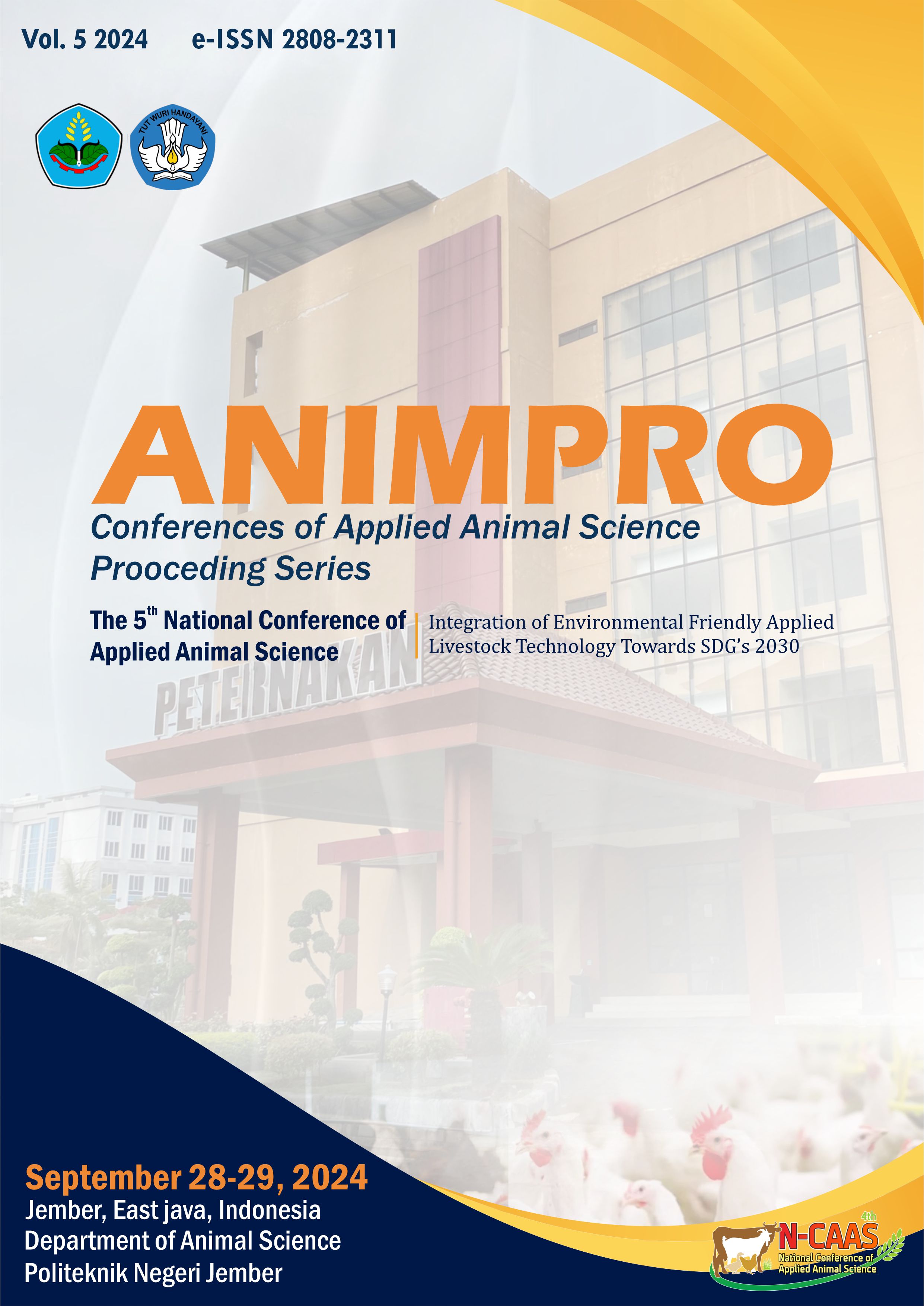Pengaruh suplementasi nano zinc dalam pakan terhadap efisiensi pakan ayam KUB
DOI:
https://doi.org/10.25047/animpro.2024.743Keywords:
feed efficiency, nanoparticles, zinc supplementations, KUB chickensAbstract
Current trial was intended to study the effects of nano zinc dietary supplementation on the growth performance of KUB Chickens. Two hundred KUB chicks were distributed randomly into five treatment levels with four replications, and ten chicks in each replicate pen. The dietary nano zinc treatments were: basal diet without nano zinc supplementation (NZ-0) and a basal diet supplementation with nanoparticle zinc oxide at concentrations of 15 mg/kg (NZ-1), 30 mg/kg (NZ-2), 45 mg/kg (NZ-3), or 60 mg/kg (NZ-4). The analyzed variable data were feed intake, feed conversion ratio (FCR), protein intake (PI), protein efficiency ratio (PER), energy intake (EI), and energy efficiency ratio (EER) based on the 10 weeks rearing period. The pooled data were analyzed statistically with one way ANOVA and followed subsequently with Duncan’s test for the data with significant difference. Results indicated that dietary supplementation of 60 mg/kg nano zinc increased feed intake, protein intake, energy intake (P<0,05), reduced feed convertion ratio (P<0,05), and increased energy efficiency ratio (P<0,01). Meanwhile, dietary supplementation of 60 mg/kg nano zinc did not affect the protein efficiency ratio (P>0,05). Taken together, our data indicated that the feed efficiency of the KUB chickens improved when the diet were supplemented with 60 mg/kg nanoparticle zinc.
Downloads
References
Yunianta., Astuti, A., Mawardi, N. K., Darini, M. T., Sastrohartono, H., . K., & Sofi’ul Anam, M. (2023). The Effect of Nano-bentonite Supplementation on Reducing the Toxicity of Aflatoxin B1 in Kampung Unggul Balitbangtan Chickens Diet. Journal of World’s Poultry Research. https://doi.org/10.36380/jwpr.2023.27
Ahmadi, F. (2013). The effects of zinc oxide nanoparticles on performance, digestive organs and serum lipid concentrations in broiler chickens during starter period. International Journal of Biosciences (IJB), 3(7), 23–29. https://doi.org/10.12692/ijb/3.7.23-29
Ao, T., Pierce, J. L., Power, R., Dawson, K. A., Pescatore, A. J., Cantor, A. H., & Ford, M. J. (2006). Evaluation of Bioplex Zn® as an organic zinc source for chicks. International Journal of Poultry Science, 5(9), 808–811. https://doi.org/10.3923/ijps.2006.808.811
Bratz, K., Gölz, G., Riedel, C., Janczyk, P., Nöckler, K., & Alter, T. (2013). Inhibitory effect of high-dosage zinc oxide dietary supplementation on Campylobacter coli excretion in weaned piglets. Journal of Applied Microbiology, 115(5), 1194–1202. https://doi.org/10.1111/jam.12307
Brugger, D., & Windisch, W. M. (2016). Subclinical zinc deficiency impairs pancreatic digestive enzyme activity and digestive capacity of weaned piglets. British Journal of Nutrition, 116(3), 425–433. https://doi.org/10.1017/S0007114516002105
Bunglavan, S. J., Garg, A. K., Dass, R. S., & Shrivastava, S. (2014). Use of nanoparticles as feed additives to improve digestion and absorption in livestock. Livestock Research International, 2(3), 36–47. www.jakraya.com/journa/lri
Dono, N. D. (2012). Nutritional Strategies To Improve Enteric Health and Growth Performance of.
ElKatcha, M., Soltan, M., & Elbadry, M. (2017). Effect of Dietary Replacement of Inorganic Zinc by Organic or Nanoparticles Sources on Growth Performance, Immune Response and Intestinal Histopathology of Broiler Chicken. Alexandria Journal of Veterinary Sciences, 55(2), 129. https://doi.org/10.5455/ajvs.266925
Hu, X., Sheikhahmadi, A., Li, X., Wang, Y., Jiao, H., Lin, H., Zhang, B., & Song, Z. (2016). Effect of Zinc on Appetite Regulatory Peptides in the Hypothalamus of Salmonella-Challenged Broiler Chickens. Biological Trace Element Research, 172(1), 228–233. https://doi.org/10.1007/s12011-015-0582-2
Masito, M., Putra, A. R. S., & Andarwati, S. (2022). The effect of Kampung Unggul Balitbangtan (KUB) chicken innovation characteristics toward the development of farmers perceptions in South Sumatra. IOP Conference Series: Earth and Environmental Science, 1001(1). https://doi.org/10.1088/1755-1315/1001/1/012027
Park, S. Y., Birkhold, S. G., Kubena, L. F., Nisbet, D. J., & Ricke, S. C. (2004). Review on the role of dietary zinc in poultry nutrition, immunity, and reproduction. Biological Trace Element Research, 101(2), 147–163. https://doi.org/10.1385/BTER:101:2:147
Pathak, S. S., Reddy, K. V, & Prasoon, S. (2016). Influence of different sources of zinc on growth performance of dual purpose chicken. J.Bio.Innov, 5(5), 663–672.
Rosi, N. L., & Mirkin, C. A. (2021). Nanostructures in Biodiagnostics. Spherical Nucleic Acids: Volume 1, 1, 13–53. https://doi.org/10.1201/9781003056676-3
Sahoo, A., Swain, R. K., Mishra, S. K., & Jena, B. (2014). Serum biochemical indices of broiler birds fed on inorganic, organic and nano zinc supplemented diets. International Journal of Recent Scientific Research, 5(11), 2078–2081.
Sheoran, N. (2017). Role of Nanotechnology in Poultry Nutrition. International Journal of Pure & Applied Bioscience, 5(5), 1237–1245. https://doi.org/10.18782/2320-7051.5948
Tabatabaie, M. M., Aliarabi, H., Saki, A. A., Ahmadi, A., & Hosseini Siyar, S. A. (2007). Effect of different sources and levels of zinc on egg quality and laying hen performance. Pakistan Journal of Biological Sciences, 10(19), 3476–3478. https://doi.org/10.3923/pjbs.2007.3476.3478
Wijnhoven, S. W. P., Peijnenburg, W. J. G. M., Herberts, C. A., Hagens, W. I., Oomen, A. G., Heugens, E. H. W., Roszek, B., Bisschops, J., Gosens, I., Van De Meent, D., Dekkers, S., De Jong, W. H., Van Zijverden, M., Sips, A. J. A. M., & Geertsma, R. E. (2009). Nano-silver - A review of available data and knowledge gaps in human and environmental risk assessment. Nanotoxicology, 3(2), 109–138. https://doi.org/10.1080/17435390902725914
Yu, Y., Lu, L., Wang, R. L., Xi, L., Luo, X. G., & Liu, B. (2010). Effects of zinc source and phytate on zinc absorption by in situ ligated intestinal loops of broilers. Poultry Science, 89(10), 2157–2165. https://doi.org/10.3382/ps.2009-00486
Zha, L. Y., Xu, Z. R., Wang, M. Q., & Gu, L. Y. (2008). Chromium nanoparticle exhibits higher absorption efficiency than chromium picolinate and chromium chloride in Caco-2 cell monolayers. Journal of Animal Physiology and Animal Nutrition, 92(2), 131–140. https://doi.org/10.1111/j.1439-0396.2007.00718.x
Zhao, C. Y., Tan, S. X., Xiao, X. Y., Qiu, X. S., Pan, J. Q., & Tang, Z. X. (2014). Effects of dietary zinc oxide nanoparticles on growth performance and antioxidative status in broilers. Biological Trace Element Research, 160(3), 361–367. https://doi.org/10.1007/s12011-014-0052-2
Downloads
Published
How to Cite
Issue
Section
License
Copyright (c) 2024 Nova Hidayati Diyah Larasati, Nanung Danar Dono, Bambang Ariyadi

This work is licensed under a Creative Commons Attribution 4.0 International License.









